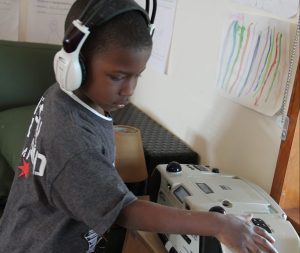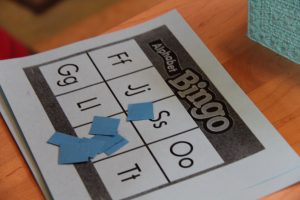7-3 Phonological Awareness
Another one of the Big Five foundations to early literacy development is phonological awareness.
A Broad Spectrum
Here is the definition of phonological awareness: “Phonological awareness refers to the whole spectrum from beginning awareness of speech sounds and rhythms to rhyme awareness and sound similarities and, at the highest level, awareness of syllables or phonemes. Phonemes are the smallest units in speech.”
How would you re-state this definition in your own words?
The ear is a powerful tool. It helps people understand words and sentences and allows them to receive and process individual sounds. By teaching children about the beginnings and ends of words, educators pave the way toward literacy. Many skills contribute to phonological awareness. It’s best for early childhood educators to focus on teaching segmenting and blending because these skills apply to other areas of phonological awareness. Draw attention to initial sounds (onsets) and word endings (rimes).
Educators should give pre-kindergarten children as much language input as possible to show them the individual sounds in the words that make up a language. Then, children will learn to manipulate those sounds in their language. As elementary school students, they will learn how to manipulate them to create and read written words.
Phonological awareness is a listening skill. Think about a phone as something you can talk and listen with (unlike phonics, which is the relation between letters and sounds.)
Phonological Awareness in Children Who are Multilingual learners
Children hearing Spanish and other phonetic languages tend to develop phonological awareness naturally. They need more targeted instruction to develop those listening skills in English.
Additionally, children with disabilities who are multilingual learners can learn phonological awareness skills in multiple languages but are more likely to have difficulty generalizing skills from one language to another without explicit and systematic instruction in both the home language and in English.
Small group or individual intensive instruction is a promising approach to improving phonological awareness skills for preschool children with disabilities. Explicit instruction is typically led by an adult who chooses materials, models correct answers, and provides feedback on children’s responses. Children are taught an easier skill before moving on to learn a more challenging one and tasks are broken down into smaller skills as needed. Learn more about individualizing instruction in the Big 5 Phonological Awareness Supplement by the National Center on Early Childhood Development, Teaching, and Learning.
Early language skills in the home language transfer to and help children develop the same skills in another language. Educators must work on phonological awareness in both the classroom and the home languages.
Some languages use sounds that don’t appear in English, and vice versa. This might make it difficult for young children to hear and use certain sounds; early exposure to various languages helps.
Working on phonological awareness for 10-15 minutes a day can make a dramatic difference in children’s awareness. That doesn’t mean that you sit down with the children and drill them on word sounds. It just points out how little time is needed with word segmentation, rhyming, and other activities that enhance phonological awareness.
Phonological awareness activities can happen throughout the day, during transition activities (Example: “One two three, come along to me” What two words rhyme?), routines, and play.
Strategies to support phonological awareness in the learning setting
Songs, Poems, and Recordings

Having many different sounds for children to hear and identify can enhance their phonological awareness. Educators should provide children with a listening center, where songs, poems, and recordings are available. Ask families to record songs and word games they use in their language and culture so children can listen to those at school.
Activities like this would work on the earlier phonological awareness skills – listening and rhyming. They might also draw children’s attention to the initial sounds of words.
Rhyming Books

Share rhyming books with young children who are multilingual learners to work on phonological awareness in English. This also helps children work on vocabulary, alphabet knowledge, and print concepts. Nursery rhymes have been used successfully to promote early phonological and print-related skills in young children with different kinds of disabilities, including vision impairment, hearing impairment, developmental disabilities, physical disabilities, and language delays. Rhyming experiences are enjoyable activities and provide critical communication skills such as joint attention and turn taking.
Games
Playing a brief game with children is another way to enhance their phonological awareness. For example, say, I’m thinking of words that begin with the sound, “K.” This sound might be made by a K or a C. You or a child could reach into a sound box and find objects or pictures that start with the “K” sound. You should also point out any children’s names that start with that sound.
Video: Matching Game (1:00)
Here’s an example of an educator playing a matching game with children. As you watch the video, think about how the educator is building children’s phonological awareness. Also think about your own practice—have you done similar activities?
Literacy Kits

As another example of fun and meaningful activities to enhance phonological awareness, a Head Start educator made literacy kits for families to borrow.
One of the activities in these kits was a matching game. The kit included pages with letters written across the top and a book. Children and families would use the letters to match words in the book that started with the sound represented by those letters.
Educators or families could make these kits with photos and toys that represent words in each family’s home language.
Other Tips to Support Phonological Awareness
Children who are multilingual learners may have phonological awareness in their home language, but it may not be apparent to educators who speak only English.
Speech sounds in a child’s first language may differ from speech sounds in English, especially sounds that are very subtly different (for example, pen and pin). Also, some speech sounds in English are not part of other languages, so children may not have had a lot of early exposure to some sounds. Children often use the closest sound from their native language when they pronounce words in English.
Here are some tips when it comes to working with children who are learning more than one language:
- Recognize children’s ability in their first language.
- Focus on words children already know.
- Remember that spoken sounds vary from speaker to speaker.
- Accept approximations as children build skills.
Everyone pronounces sounds uniquely, so encourage children to attempt sounds that are not part of their home language.
references
August, D. & Hakuta, K., Eds. (1997). Improving schooling for language minority children: A research agenda. National Academy Press, Washington D.C.
Cultivate Learning, University of Washington. (2019). Phonological Awareness Example [Video file].
Gottardo, A. (2002). The relationship between language and reading skills in bilingual Spanish-English speakers. Topics in Language Disorders, 22(5), 46-70. [Journal article]
National Center on Early Childhood Development, Teaching, and Learning (2019). Phonological Awareness. [PDF]
National Center on Early Childhood Development, Teaching, and Learning (2019). The Big 5 Highly individualized teaching supplements: Phonological awareness. [PDF]
Quiroga, T. et al. (2002, Feb). Phonological awareness and beginning reading in Spanish-speaking ESL first graders. Journal of School Psychology, 40(1), 85-111. [Journal article]
Scholastic (2019). Getting the p-words straight. [Online article]
Cite this source:
EarlyEdU Alliance (Publisher). (2020). 8-3 Phonological Awareness. In Supporting Multilingual Learners Course Book. University of Washington. [UW Pressbooks]

